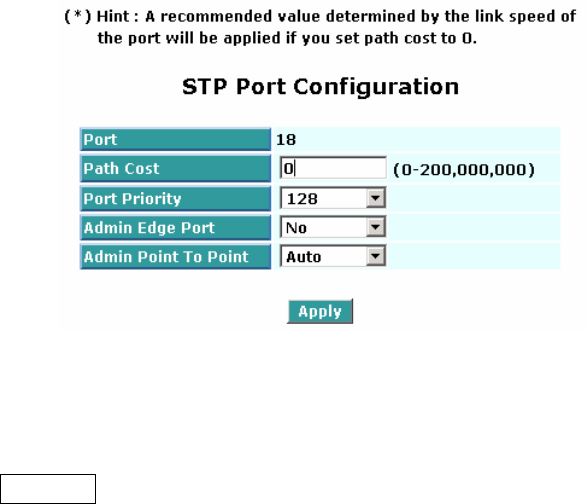
y Priority:
Priority here means Port Priority. Port Priority and Port Number are mixed to form the Port ID. Port IDs
are often compared in order to determine which port of a bridge would become the Root Port. The
range is 0 – 240.
Default is 128.
y Admin Edge Port:
If user selects “Yes”, this port will be an edge port. An Edge Port is a port connected to a device that
knows nothing about STP or RSTP. Usually, the connected device is an end station. Edge Ports will
immediately transit to forwarding state and skip the listening and learning state because the edge ports
cannot create bridging loops in the network. This will expedite the convergence. When the link on the
edge port toggles, the STP topology keeps unchanged. Unlike the designate port or root port though,
an edge port will transit to a normal spanning-tree port immediately if it receives a BPDU.
Default: No
y Admin Point To Point:
We say a port is a point-to-point link, from RSTP’s view, if it is in full-duplex mode but is shared link if it
is in half-duplex mode. RSTP fast convergence can only happen on point-to-point links and on edge
ports. This can expedite the convergence because this will have the port fast transited to forwarding
state.
There are three parameters, Auto, True and False, used to configure the type of the point-to-point link.
If configure this parameter to be Auto, it means RSTP will use the duplex mode resulted from the
auto-negotiation. In today’s switched networks, most links are running in full-duplex mode. For sure,
the result may be half-duplex, in this case, the port will not fast transit to Forwarding state. If it is set as
True, the port is treated as point-to-point link by RSTP and unconditionally transited to Forwarding
state. If it is set as False, fast transition to Forwarding state will not happen on this port.
Default: Auto
y M Check:
Migration Check. It forces the port sending out an RSTP BPDU instead of a legacy STP BPDU at the
next transmission. The only benefit of this operation is to make the port quickly get back to act as an
RSTP port. Click on M Check button to send a RSTP BPDU from the port you specified.
3.13 Trunk
The Port Trunk Configuration is used to configure the settings of Link Aggregation. You can bundle more than
one port with the same speed, full duplex and the same MAC to be a single logical port, thus the logical port
aggregates the bandwidth of these ports. This means you can apply your current Ethernet equipments to build
40


















